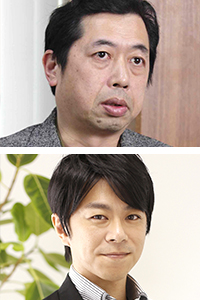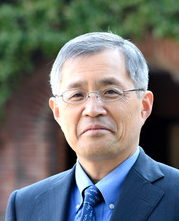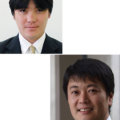Future Design
Discussion between Professor Sakura Osamu and Professor Saijo Tatsuyoshi

Professor Sakura Osamu (left) and Professor Saijo Tatsuyoshi
There are various matters, such as climate change, energy issues, social security, and government debt, which need to be dealt with using a long-term perspective. At the core of these issues is conflict between the interests of different generations. There is potential for the short-sighted response and decision-making of the present generation to significantly disadvantage future generations. These future generations are not yet born so cannot make their voices heard nor negotiate with the present generation. Yet, it’s not strange at all for the present generation to make decisions according to their own interests. The “market” and other social systems are not necessarily equipped with any function for distributing resources to future generations. In order to create a sustainable society for future generations, humans need to get past their natural short-sightedness, while mechanisms and systems to compensate for this deficiency are needed. “Future design” involves thinking about these issues. Professor Sakura Osama spoke to Saijo Tatsuyoshi, the originator of the concept of future design.
Sakura Osamu: Professor Saijo, in your account of future design you point out that, while the fundamental economic and political mechanisms (i.e. the market mechanism and democracy) function reasonably well, they do not function well when it comes to thinking about future generations. You also note that the situation is made worse by a human biological characteristic, which is to acquire the maximum amount of resources as soon as possible. The latter we can understand well from an evolutionary research perspective. As for the former, is that a limitation of these systems, or do the systems not have the capacity to deal with these issues well? I’d like to ask you about these and related issues today. But first, please tell me about future design.
Saijo Tatsuyoshi: I will start by talking about why I proposed the concept of future design. In 2012, I held a seminar at the University of Massachusetts on social dilemmas. During a meal after the seminar, we started to talk about how, when thinking about the future, it is a problem that future generations are not yet born. So, I suggested: “how about we create imaginary future generations among the present generation?” And then the wife of Professor John Stranlund, my former graduate student at UC Santa Barbara, told me about the Iroquois native Americans, who consider the seventh generation ahead when they make their decisions. I was really struck by this and, together with researchers from Osaka University and Kochi University of Technology, started laboratory experiments featuring imaginary future persons.
Since 1950, various economic indicators, such as fossil fuel consumption, population, and GDP have risen ever faster. Yet, according to climate change researchers, if we keep on going like this, in various fields we will start to reach the point of no return. As I’m sure you know, Professor Sakura, the destruction of most of our biodiversity has already begun. What’s more, recently climate change researchers have started to say that, even if we implement the Paris treaty commitments, it is still possible we will have a hothouse earth. I believe that this really is a consequence of our current market and democracy.
The fundamental thinking behind future design is to ask what kind of social mechanisms we should create in order to deal with this. There are various social mechanisms that regulate the basic social mechanisms of democracy and the market. Of course, things won’t necessarily go well if we use the same mechanisms in regions with different cultures and histories. We did experiments involving experimental subjects in Japan, Bangladesh, Nepal and other countries; and it wasn’t necessarily the case that mechanisms that worked well in Japan worked well in other countries.
Sakura: Please tell me a little more about the experiments in Nepal and Bangladesh.
Saijo: We made “generation groups” of three people and had them choose between option A and option B. Option A was a large sum of money, while option B was a small amount. If we left it at that, everyone would choose option A, wouldn’t they. But, in fact, in the experiment if the first group chose option A, the option A and B money would decrease by nine dollars for the following generation. Meanwhile, if they first chose the smaller option B sum, the next generation would be able to choose from unchanged option A and option B amounts.
When we did this experiment with Kochi University of Technology students, we asked one person from each group of three to “represent future generations and negotiate with the other two.” The majority of these groups chose option B. Yet, when we did this in Dhaka in Bangladesh, there was barely any effect. That was a surprise. Even in Bangladesh, in the countryside the majority of people chose option B, and when we introduced the imaginary future people, even more chose B. Yet, in Dhaka around 30% of people chose option B, and even when imaginary future people were introduced there was no difference. So, maybe there would be an effect if we changed the “social mechanisms” a little? First, we had all three consider the choice as a future generation, then return to their role as the present generation and think again. If they wanted to make different decisions, they could decide by a majority. This “majority decision” is contemporary democracy. That’s probably why it changes when a process is added to democracy. When we actually tried, there was a big change.
Sakura: How should we interpret that?
Saijo: Well, they can understand that people in the future would like them to choose option B. So, having experienced that perspective, it probably wouldn’t be that easy for them to choose option A when they go back to being a member of the current generation. We are now starting experiments together with neuroscientists. We are starting to investigate how people are able to change.

Prof. Sakura
Sakura: Creating various mechanisms while considering regional differences and linking them together; at the same time, there are global environmental issues, aren’t there. So, there are different local mechanisms but also responses to environmental problems affecting the whole globe. I can’t yet link those properly together in my own head. I think there is still a distance between the local and the global.

Prof. Saijo
Saijo: It is a fractal, isn’t it? [ed. Future design makes use of fractal thinking to resolve issues.] In fact, the local mechanisms that we are thinking about could also be used in the same way by world leaders. For example, if the G7 leaders devoted some time to thought about what they would do now if they were a future generation then their actions probably wouldn’t be governed by thought of present benefit. We are considering the introduction of imaginary future people at various levels.
Sakura: For there to be a few more people who think about the future, is it also a matter of something like personal mindset?
Saijo: Yes, it is probably by changing personal mindset that policy changes. For example, if even a minority of a few people in every ten change their way of thinking, they will probably influence the whole.
Sakura: In reality, politicians need to win elections, so they make election promises about immediate concerns — including in the regions — and refer to long-term issues. So, if voters changed a little, they might choose politicians who paid attention to future problems.
Saijo: That’s right. For example, if there were 10 representatives, I’d like to create a system where three were “future representatives,” and have candidates compete on “future issues.” I am talking about whether we couldn’t create a social mechanism where, if present day Diet members talked only about their own profit as representatives of interest groups, “future representatives” would say, “if you do that, these problems will occur.”
Sakura: Professor Saijo, in the town of Yahaba, Iwate Prefecture you have introduced future design to systems such as water rates and are taking some practical action. Please tell me a little about that.
Saijo: Actually, the person responsible for water supply operations in Yahaba, Yoshioka Ritsuji, is a pioneer when it comes to future design projects. He has been responsible for the water supply operations division for a long time. Water supply involves investing in pipes and other infrastructure, but if the money to invest in infrastructure disappears the water supply cannot be maintained. Water division managers from local governments all over Japan are facing a situation where it would take over 100 years just to renew infrastructure using current funding and maintaining water supply will be impossible. Therefore, Yoshioka gathered residents together, disclosed all the information about water supply operations, and had them discuss the issue. When residents thought about the future, they realized that things wouldn’t turn out well if they went on as they were and started to propose raising water rates.
That took seven years. The town has various policies, and he said that if one policy takes seven years, things are looking bleak [laughs]. We thought if we made use of our proposed imaginary future people, he might be able to draft policy quickly, so from 2015 to 2016 we started to put that into practice together. At that time, by chance the Cabinet Office had requested that all Japan’s cities, towns, and villages create “2060 Plans,” and said they would make modest assistance payments for good plans. So most of the cities, towns, and villages across Japan hired consultants [laughs]. Even though Yahaba also hired a consultant, they decided to take up our plan.
Once a month over a period of half a year, we gathered a group of residents and created two groups representing imaginary future generations and two groups who thought about the future from the perspective of the current generation. We had both think about policy. We told the residents who were part of the imaginary future generations that we wanted them to travel in a time machine to 2060 and think about the issues from there. That’s all we did, but the contents of their discussion were completely different. It was a real surprise. When they thought about the future from the perspective of the current generation, they saw things that were problems for them now as issues for 2060; for example, “it would be a problem if there are still waiting lists for childcare in 2060” or “it will be a problem if there are too few hospitals or elderly care facilities.” That was the same no matter how many times they talked. The imaginary future generation groups, however, started to think about what they should do now to make themselves happy in the world of 2060. In Yahaba there is a small rice-ball shaped mountain called Nanshozan. It has emotional importance for residents but is in very poor condition. The groups proposed things such as turning the mountain into a nature park. They also started to think about what to do about money. The groups discussed various things that really could happen in practice (of course, they also considered impractical things too). For example, they started to discuss how when it gets to 2060, the robot Pepper would scan their body during the night, then when they get up in the morning arrange a hospital appointment if he had found something wrong. When the time for the appointment came, a car without tires would come to pick them up.
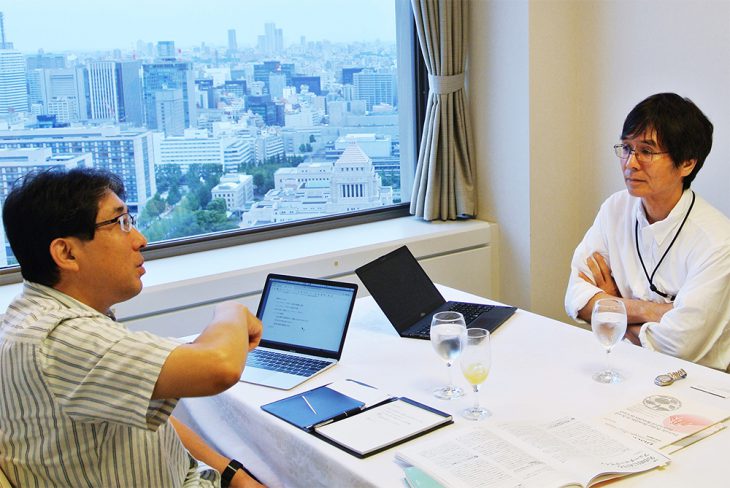
Sakura: They looked at themselves from the different context of a future generation, didn’t they? I think that once they can see things that are not apparent in their current lives, they get an overview of what they are doing and can take a relative perspective.
Saijo: Yes, you are right. About six months later researchers from the Kochi University of Technology conducted interviews. They discovered that the imaginary future people didn’t experience an internal battle between their “present-day self and “future self,” but rather that they had an overview of both. What’s more, they said the following: “It is fun to think as a future generation.”
Sakura: Fun? Was that also true for elderly people? There was no relationship with age?
Saijo: It was very much the same for elderly people. Just by having six monthly three-hour sessions, even half a year later they said that “I end up thinking about nature” or “Even when I shop in the supermarket, I end up thinking about nature.” We thought that when they finished the six sessions they would completely forget, so it was surprising. The attitudes of those who become future imaginary people have changed.
Sakura: Once they change, will the change last long?
Saijo: Of course, it didn’t apply to absolutely everyone, but we began to think that, if we can increase the number of such people even a little, there is no doubt that society’s decision making will change. Even more interestingly, there was a real battle at the end when the group that thought about the future from a present-day perspective negotiated with the group that thought about the present from a future perspective. The future generation felt that the things that the present generation proposed were “wrong.”
Sakura: I see [laughs].
Saijo: It would have been bad to split the town into two [laughs], so next we changed the mechanism a little. The first time the present considered the future, then next the future considered the present.
Sakura: They swapped places?
Saijo: No, the same people took on both roles consecutively. We had them reflect on which is the better role to take. Using this mechanism, we had them think about the town’s public housing when the time for rebuilding comes up. The first time was a standard workshop during which the present generation considered the town’s public housing. They received 5,000 yen for each three-hour workshop, so they did talk, but they didn’t come up with ideas. It seems that participants thought that public housing was a place where poor people live so it wasn’t to do with them [laughs].
Sakura: They come to earn some pocket money [laughs].
Saijo: I guess that’s right. Then, one month later we said, “Right… today you will think about the same thing, but you will all travel in a time machine to 2050 (the lifespan of the town’s public housing), so please consider it from there.” When we did that, the contents of their discussion suddenly changed.
Sakura: The same people?
Saijo: Yes. The talk changed to things like: “The people living in the municipal public housing are Yahaba residents like us,” and “Do you know about the toilets in the municipal public housing?” They started to say things like: “They have Asian-style toilets, you know.” “When it is really cold, there are places that the heating doesn’t reach, so elderly men and women can’t bear to live there.” It was a surprise. Various ideas started to emerge one after another, such as: “Why don’t we do car sharing?” (since not everyone living in the municipal public housing has a car) or “There is really no need to rebuild the housing in the same location, so in the future why don’t we build it somewhere where everyone already gathers?” Why this change? These were exactly the same groups, the same people. Yet, a month later this kind of discussion started.
Sakura: It is quite moving.
Saijo: I was surprised when I heard it. People’s attitudes can change that much. I started to realize that if we create the right mechanisms, the town’s decision making may start to change. Of course, just by doing that it won’t change dramatically in every respect.
Sakura: It was certainly dramatic, but the way that people’s opinions changed was also very interesting. I thought that they might be able to successfully become imaginary future generations, but I had doubts about how you would overcome criticism that it was very vague. But listening to what you have just said, that wasn’t the case. People became members of the future generations and thought about the issues. That’s the important thing.
Saijo: That’s right. Elderly people came up with some good ideas. That’s because they thought about after they would die. It may be because they can separate themselves from personal interest, or maybe a motivation to leave behind some evidence of their lives is at play.
For example, there’s the case of Suita in Osaka Prefecture. There was a session to consider future design for Suita. At that, an old man in the imaginary future person group said that he’d “like [the city] to be self-sufficient in food.” Then a young person asked, “Where are the rice fields in Suita?” The old man started to explain: “I’m not thinking Edo-period farming. It would use cutting-edge technology; for example, growing vegetables in buildings.” Everyone had heard similar things, so there were all sorts of comments. Then the conversation came to the point: “Science… science… who’s going to provide this science?” But Osaka University is based in Suita, so someone said, “Osaka University.” As it happened, a student from the university was present. “Osaka University doesn’t have a department of Agriculture,” he said. “You should make one,” came the reply. Next, everyone started talking about creating a department of agriculture at Osaka University. Osaka has a competitive relationship with Kyoto, so there was quite an excited discussion about “We don’t want to make a department of agriculture like Kyoto University’s” [laughs] and “We will create a new type of agriculture department that fuses engineering, science, biology and more.” When someone asked, “But where will we build it?” a middle-aged man said, “I’ll give you the land” [laughs].
Sakura: That’s reassuring [laughs].
Saijo: They are from the Kansai region [including Osaka, Kyoto and Hyogo]. As you know, these people tend to be very hasty, pragmatic and rich in ideas [laughs]. It turns out that there is the National Cerebral and Cardiovascular Center to the north of Osaka University, but since that will relocate, a large area of land will be vacant. A Suita City employee was listening to the discussion and said, “No matter how hard we try, we couldn’t do something like this.” In a matter of hours, they came up with a proposal for a new Osaka University department of agriculture. When creating new ideas for the future, it is no good to simply gather residents together and make them think about the future.
Sakura: That participation by residents is important, isn’t it? Participation by residents is quite common but usually it ends up being based on what is wanted and tends to just cost money.
Saijo: Perhaps if imaginary future persons consider the future, it will become based on happiness? They might think about what should be done to make future people happy. Human attitudes can really change. Also, once they say it, i.e. talk about their own ideas in their own words, they will appreciate that they can’t go back to how they were.
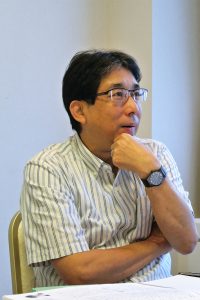 Sakura: It becomes a situation where they are forced to commit themselves. These examples of people dramatically changing their attitudes have been studied in terms of psychology and biology. But because people can suddenly change just by putting themselves in the shoes of a future generation, can’t we surmise that humans are wired to do that in the first place; and that while this is dormant amid today’s extremely short-term thinking, with small changes it will function well?
Sakura: It becomes a situation where they are forced to commit themselves. These examples of people dramatically changing their attitudes have been studied in terms of psychology and biology. But because people can suddenly change just by putting themselves in the shoes of a future generation, can’t we surmise that humans are wired to do that in the first place; and that while this is dormant amid today’s extremely short-term thinking, with small changes it will function well?
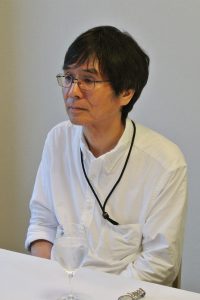 Saijo: At first, we just thought that the method we devised had worked well, but for people to change their attitudes this much, it has to be something that they have from the beginning. We named it generally as “futurability,” a type of wiring where “For example, even if I struggle, I will be happy if people in the future do better.” In a sense, we thought that we had discovered this and started to discuss what kind of social mechanisms we could devise to activate this future possibility.
Saijo: At first, we just thought that the method we devised had worked well, but for people to change their attitudes this much, it has to be something that they have from the beginning. We named it generally as “futurability,” a type of wiring where “For example, even if I struggle, I will be happy if people in the future do better.” In a sense, we thought that we had discovered this and started to discuss what kind of social mechanisms we could devise to activate this future possibility.
Sakura: I think it would be pretty tough if that wiring didn’t exist, but I feel that if we can successfully activate this existing wiring, there is a lot of hope.
Saijo: I think it is true that pre-industrial revolution generations had a lot of it.
Sakura: They say that the Iroquois native Americans still have it today.
Saijo: It is impossible to check, but I think that people with the same genes born before the industrial revolution vs after would say different things in their discussions. We would like to somehow change social mechanisms to successfully activate this thing that resembles a social nature or futurability. I think that in changing it, decision-making would also change.
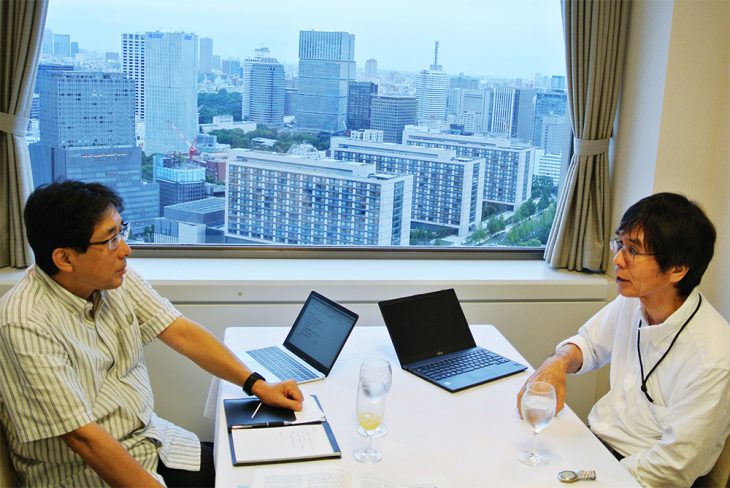
Sakura: Today, in Japan and many other developed countries, people don’t desire the dramatic economic growth they did before. Because resources are obviously limited and the population is not growing, it is necessary to change social structures themselves. But we can’t discard the mechanisms of democracy and the market. All we do is patch them up with festival-type events such as the Olympics and expos [laughs]. It was all quite fuzzy in my mind, but you really are getting somewhere, Professor Saijo. I am relieved. It isn’t a vaccination, but if we work a little of this stuff into learning and the school curriculum, the effect might be long lasting.
Saijo: The members of our team think there’s no need for odd “moral education” [laughs]. For example, if a child in the third year of elementary school likes trains, we’d like them to think about the town’s transport system ten years from now. They all have various things that they like. When these children become adults and a problem crops up in the town, they can participate.
Sakura: If it is something they like they will think about it hard.
Saijo: We wouldn’t force them to think about it; rather suggest that they all think about the medical system and create it, just as when we are children we think “this is how the transport system is now, but it really should be like this.” That’s why we are thinking about how to make a society where we don’t just leave it up to politicians, but a “division of labor” for thinking is created, and where it is natural to take part. If children did this for an hour a week as part of their school education, they would get used to it. We’d like to switch to a society where people don’t just keep quiet when a problem happens in the town.
Sakura: It is wonderful when ideas about what is necessary to maintain all the social systems from a broad perspective occur spontaneously.
Saijo: It would be good if that happens. Once a discussion with legitimacy emerges, one can’t easily object based on personal interest. We’d also like to change education. So that’s why we also change the political structure… democracy too. When we talk about that, most people say: “But isn’t that direct democracy?” Yet, it is not. I tell them that we would do it according to everyone’s special areas of expertise.
Sakura: It’s a viewpoint from where future design supplements special interest in different ways, isn’t it?
Saijo: There are different regions, different histories, and various different conditions. So, I think it is good to have a society that acknowledges that, “even though the neighboring town is like that, we will do it like this.” They would think about the mechanisms themselves too.
Sakura: This concept has already spread quite widely within local governments, but going forwards, will you develop your research using the expertise and data you have built up, or will you just continue to implement it more widely?
Saijo: No. Research and practical application are both essential. We take videos when applying future design in practice, create a package and provide it to others. But we are also producing research results. We have started future design workshops during which, at a particular location we’ve provided, civil servants, researchers, and ordinary people gather together and exchange ideas. There might be dentists and high-school students present. You can hear some surprising remarks. After you have worked with residents for a while you realize that they are clever. Of course, because they have lived in that place for decades, they have a huge amount of knowledge. I think that it would be wrong for a University of Tokyo professor to be invited to those towns and tell the community: “You should do this.”
In the future, we’d like to spread this not just to Japan but to the world; and to communicate it to people in different fields we have made a kamishibai [a form of street theater using illustrated boards].
Sakura: Kamishibai?
Saijo: So that they can understand what it is to become an imaginary future person, we stage a ten-minute kamishibai that portrays the experiences of people who successfully became imaginary future people. We’d like children and residents to understand. But we also want the making of a kamishibai like this to be scientific.
Sakura: It would be really great if corporate leaders would think about this. Recently, when we talk to different business-people they all understand and say things like, “Japan can’t keep going on like this,” or “We need to change the system.” But when you say, “Why doesn’t it change?” since the leaders of big corporations in particular change every two or three years, they say: “We’ll get by doing anything during my time” [laughs]. There are a lot of people who agree that this is the core problem. We really need to get to those top leaders.
Saijo: I agree. We particularly want corporate decision-makers to use future design. And a number of companies like that have started to appear. Once a few places have had some success, I think things will change. There are many people in the corporate world who really want to be useful to society, so we’d like to create some examples of success that go beyond personal profits.
Sakura: I really hope that it goes well. It’s an innovative idea that has emerged from Japan. What’s more, it is spreading in a very practical and grounded form. I believe this is a combination of academia and practical initiative that Japan should be proud of. What do you think about that?
Saijo: Since this year or thereabouts, we have been introducing our work at overseas research institutes. Last week I gave presentations at Pennsylvania State University and Duke University. They are all researchers into sustainability, so they have trouble putting that into practice.
Sakura: Them too.
Saijo: So, when I tell them, “This is the research I do,” they accept it without resistance. And, if people’s attitudes can be changed, I want to change them. So, I am thinking to travel abroad a little at a time and have people hear about our research results.
I’d also like to do more of that in Japan too. In fact, there are researchers in places that I don’t know about starting to do research. By chance, around November 2017 I was in an elevator in the Shin-Marunouchi Building when Professor Kobayashi Keiichiro got in and said, “Professor Saijo, recently I’ve been doing future design too.” I was surprised. Japan has national debt equivalent to more than two years’ GDP and might go bankrupt in the future, but he has started to think he will introduce talk of an “imaginary future”; something different to the methods of the past. In fact, the national debt and other similar problems that involve the future have a similar make-up. People from the Ministry of Finance have also started to join our research team.
Sakura: To begin with, you specialized in economics, didn’t you? That was your specialty [laughs].
Saijo: That’s right [laughs].
Sakura: In that sense, there is the same structure everywhere. To state it very strongly: we must settle the bill that the modern age has accumulated since the industrial revolution.
Saijo: We can’t go back to being pre-industrial revolution humans, but I am beginning to think that we must design social structures that activate the futurability we have within us. If we don’t do that, our continued existence itself is at stake.
Sakura: It really isn’t anything to laugh about, is it. It seems like it will become a really practical issue.
Saijo: This year there were flood disasters in different parts of Japan and I’d like those victims to use future design.
Sakura: You can create a space where people can utilize abundant local knowledge and understanding from their daily lives, then support them from the sidelines. That’s because victims have lots of knowledge about the disaster-hit areas.
Saijo: If you set up those mechanisms in advance, then when something happens, they can think what to do. We told them: “We are not thinking to tell them to do this or that. We will change the social framework. In the future, we want to change to a society where residents themselves think about that framework.
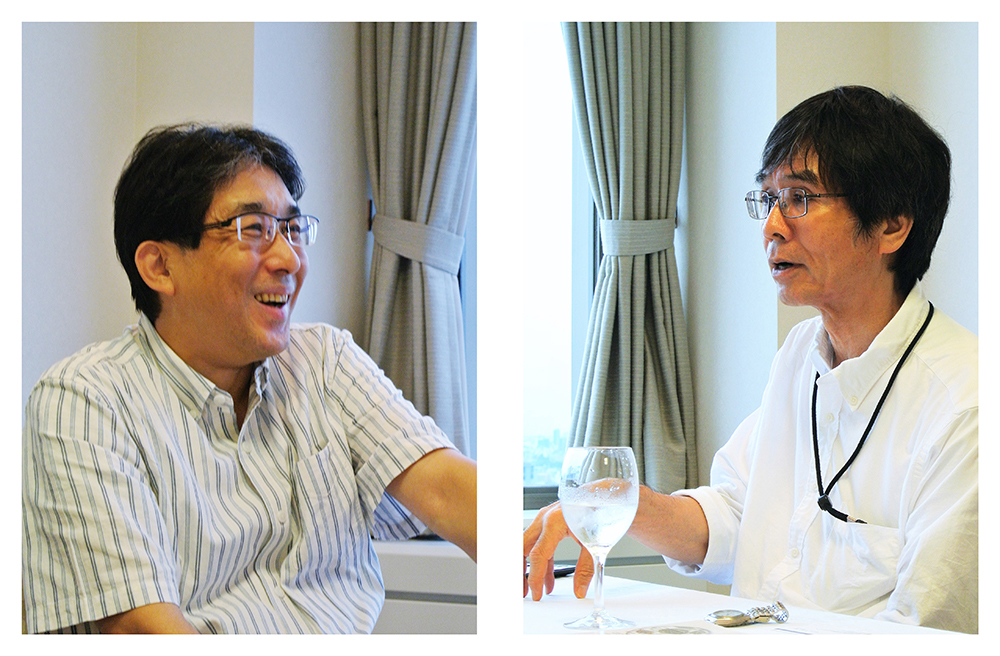
Sakura: It is a kind of dream. Like “Yes, we can.”
Saijo: In fact, the town mayor of Yahaba issued a “Future Design Town Declaration.” He intends to draw up a “We Will Change Our Town Using Future Design” general plan that uses the future design methodology. I’m looking forward to seeing what proposals the residents come up with.
Sakura: It started with the water supply in Yahaba, and now it is established with the mayor and others saying, “Let’s use this.” It would be great if there were more local governments like that. Thank you very much
Note: Transcript of an interview on September 12, 2018
Related article: https://www.japanpolicyforum.jp/archives/economy/pt20190109210009.html
Keywords
- Future Design
- present generation
- future generation
- social dilemmas
- Iroquois native Americans
- social mechanisms
- future representatives
- Yahaba Town, Iwate Prefecture
- Future Design Town
- present-day self
- future self
- futurability
- imaginary future

